What goes best with a fresh warm scone? In my experience, Devonshire Cream and Lemon Curd. Its traditional and delicious. But what is Devonshire Cream? In short, its a creamy spread that has been topping scones for centuries. Along with a curd or jam, cream is a must for your scone and Devonshire Cream is my choice.
Some Background
Traditionally, any tea enthusiast will tell you that your scone needs to have cream. As early as the 11th century, there is documentation that the monks in Devon England would eat bread with cream and jam. They began serving this to workers and ultimately to other people as what is known today as a Devonshire Cream Tea. Since then, the practice of eating scones with cream and jam has continued. That’s just a snippet of its beginnings.
But what about the cream? Clotted cream originated in Southwest England, either in Cornwall or Devon, depending on who you ask. There are essentially 3 types of creams that have classically been served with scones – Clotted Cream, Devonshire Cream, and Double Cream.
- Clotted Cream – A silky, golden-yellow cream made by allowing unpasteurized cow’s milk (traditionally from Jersey cows) to sit for 12-24 hours in shallow pans, then slowing heating it and leaving it to cool for another 12-24 hours. The cream that rises to the surface and “clots” is skimmed off and served with scones, berries, or desserts. Clotted cream has a minimum of 55% butterfat.
- Devonshire Cream – Clotted cream produced in the county of Devon, England. Interestingly, in Devon, cream is traditionally spread first on a scone, then topped with jam. In Cornwall, it’s the opposite: jam first, then cream.
- Double Cream – A dense cream skimmed from the surface of milk. With a butterfat content of 48%, it is much more decadent than whipped cream but slightly lower than clotted cream.
In the United States, we can obtain clotted cream and Double Cream in import shops, specialty stores or we can attempt to make our own. For me, I have used what some would call a mock Devonshire Cream. For me, its easier than finding unpasturized milk. It has been what I have served for years and have had at several tea rooms around the United States. Sometimes controversial for the purest, this cream presents a reasonable option that provides a delicious spread for your scones. So here’s how you make it!
Ingredients
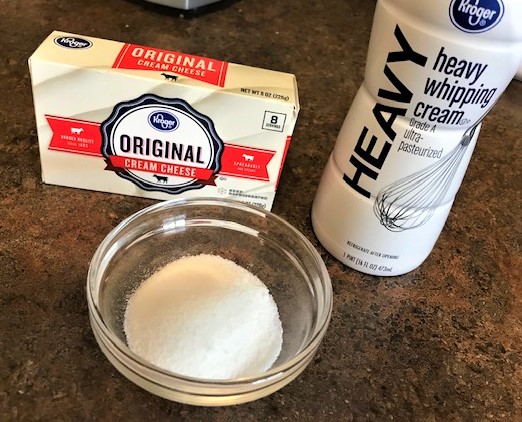
Devonshire Cream is very easy to put together and has very simple ingredients. Heavy whipping cream, cream cheese, and sugar. That’s it. Some recipes have variations – addition of sour cream, vanilla or salt, but I prefer this recipe.
Putting it together
You will need 3 ounces of cream cheese. This needs to be at room temperature. This is critical, so take it out of the refrigerator and make sure its getting soft. If not completely softened, your Devonshire Cream will be lumpy.
Next, your mixing bowl and whisk need to be very cold. So put them in the freezer while you are waiting for the cream cheese to come to room temperature.
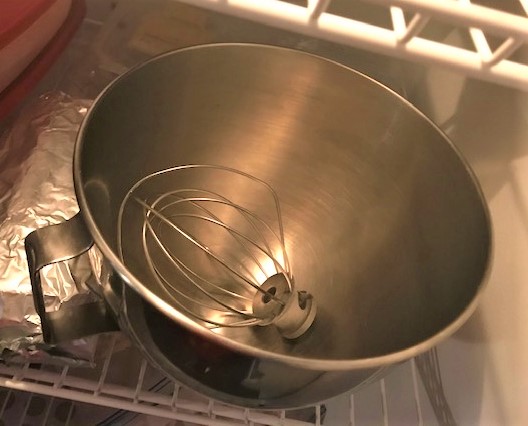
Measure out 1 cup of cream. This also needs to be well chilled. And finally, measure out 1 tbsp of white sugar.
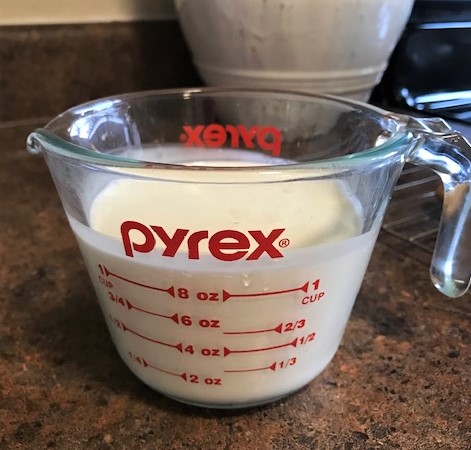
First, place your cream cheese in your mixing bowl and whip until fully smooth. Next, pour in your chilled cream and whip until fully incorporated with the cream cheese. Add the sugar and continue to whip until stiff peaks are formed, almost close to butter.
Once finished, store the Devonshire Cream in the refrigerator for up to one week. It can be frozen – just bring to room temperature and stir to make sure its smooth.
This Devonshire Cream is not overly sweet. When paired with either jam or curd, the slightly tangy cream cheese brings out the flavor of any other topping. If you prefer a sweeter version, just add more sugar as you are whipping the cream. Some recipes will call for powdered sugar rather than white sugar.
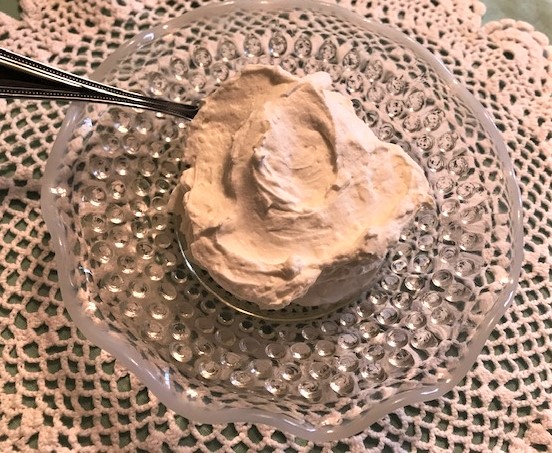
How to use your cream
There are several things you can do with your Devonshire Cream.
If serving for an afternoon tea party, scoop several servings into a dish for your guests to enjoy with their scones. Does the cream go first or does the curd or jam go first? Though it doesn’t seem like a critical issue, if you are from Devon, the cream traditionally goes on the top followed by the jam or the curd. If you are from Cornwell, its jam or curd first, followed by the cream. For me? I don’t think I have a preference – just give me a nice scone and include some cream and curd….throw in a cup of tea and I am happy!
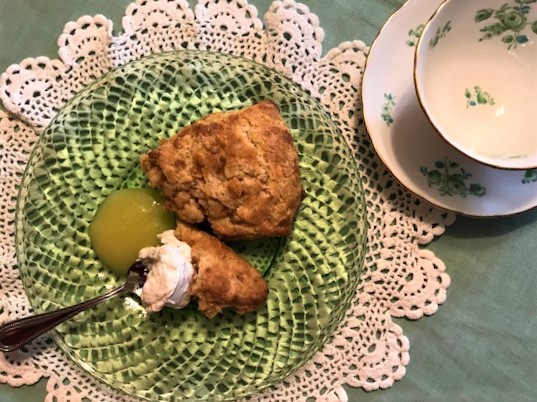
Devonshire Cream is great with delicious quick breads such as my Whole Wheat Pumpkin Bread. You can also use it as a fruit dip. Or as a filling to a cake or even a pavlova. And if you asked my afternoon tea guests, they like to just have a spoonful!
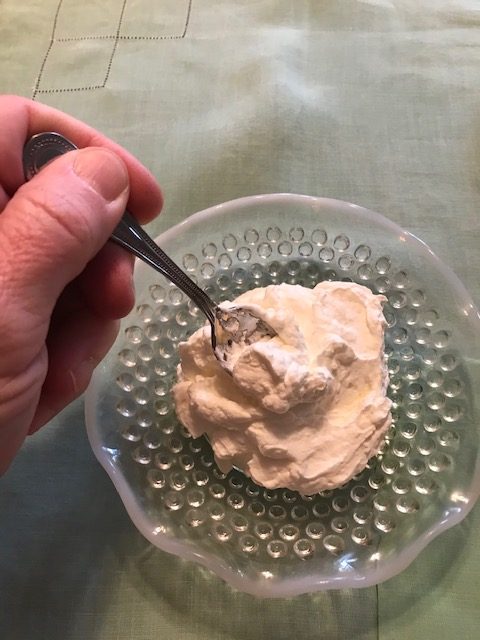
However you enjoy your Devonshire Cream, it makes your tea and scones complete.
The following products were used in the making of this recipe.
This post contains affiliate links and I may earn compensation when you click on the links at no additional cost to you Look through the products and enjoy!
Historical information was obtained from the following sources: https://en.wikipedia.org/wiki/Clotted_cream , https://ancientfoods.wordpress.com/2012/12/14/devonshire-clotted-cream-a-bit-of-history/, https://www.thekitchn.com/whats-the-difference-clotted-c-87144
Devonshire Cream
Ingredients
- 3 ounce cream cheese Must be at room temperature
- 1 tbsp white sugar
- 1 cup heavy cream
- 1 pinch salt
Instructions
- In a mixer bowl, whip the room temperature cream cheese
- Add sugar and salt
- Beat in whipped cream until stiff peaks form
- Chill until serving
References for this article:
- Whats the difference in clotted cream? https://www.thekitchn.com/whats-the-difference-clotted-c-87144
- Clotted Cream https://en.wikipedia.org/wiki/Clotted_cream
- Devonshire Clotted Cream – A bit of history https://ancientfoods.wordpress.com/2012/12/14/devonshire-clotted-cream-a-bit-of-history/
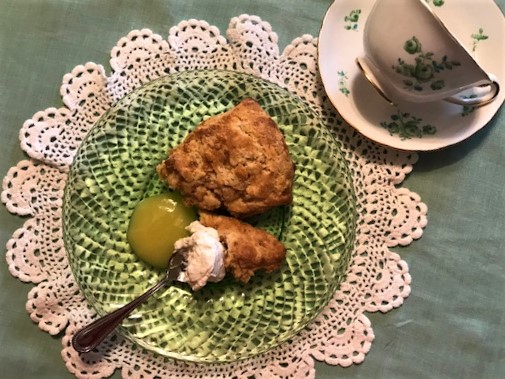
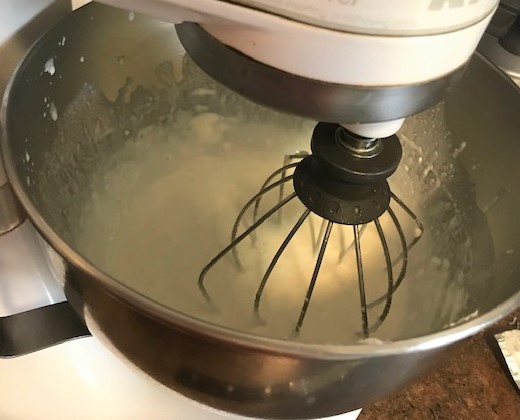
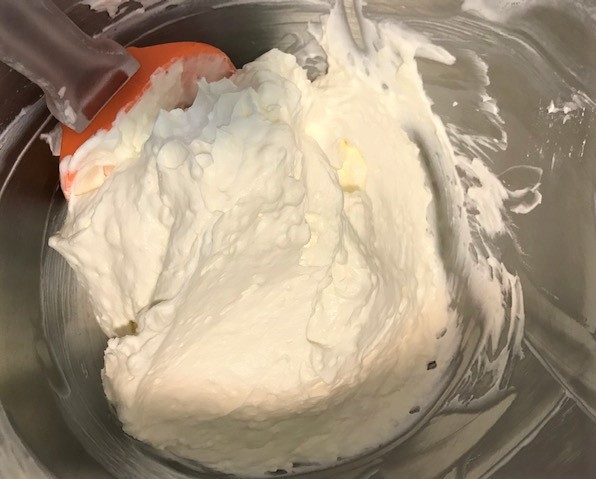
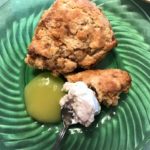


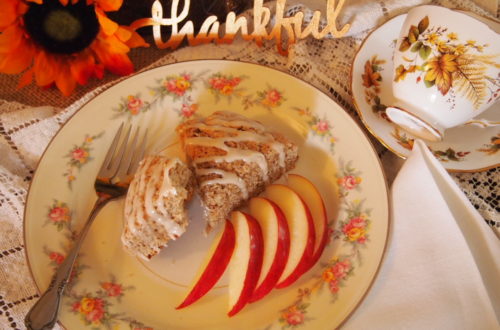
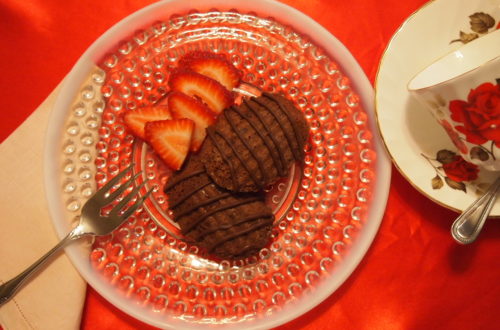
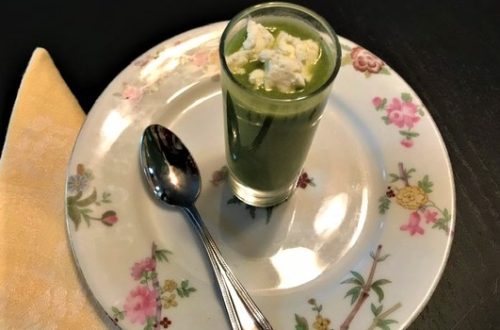
70 Comments
Holly
I love devonshire cream! Thank you for this easy recipe, I can’t wait to try this recipe!!
Beth
Hi Holly – so glad that you enjoyed the post. I love it as well. Enjoy!
Cora
Mmmmm, this sounds scrumptious!! I love having tea too and miss the teas we used to have back in North Dakota where I grew up. BUT I have 2 little girls now so I foresee many tea-parties in our future. 😉
Beth
Hi Cora – so glad that you enjoyed the article. I have sisters, a daughter and daughter in law and three granddaughters. We have teas for sure and love topping our scones and breads with Devonshire. It has become a sweet tradition that we all enjoy. Do have this with your daughters – they will love it. Thanks!
jen
I want you to know I read this in a terrible English accent. I am absolutely making this next time we have a tea party, accent included!
Beth
Hi Jen – that is toooo funny. Love that you got into character. So glad that you enjoyed the article and delighted you could have some humor with it. Enjoy! And thanks…you made me chuckle for sure.
Connie S Rhodes
Jen your comment made me smile!
Karie
I had no idea scones even had cream. Looks yummy!
Beth
H Karie – Glad that you enjoyed the post. Yes – its a favorite for scones and breads for sure. Once you try it, you will want that some lemon curd for sure. Enjoy and thanks for your comment.
Lucy
seems super easy to make, will need to look into it!
Beth
Hi Lucy – as long as your cream cheese is room temperature, it is very simple and comes together quickly. Its great to have on hand for scones but also other breads and fruits. Enjoy and thanks for your comments!
Lisa
This looks so incredible and tasty! We will share with my daughter in hopes that she makes some for us!!
Beth
Hi Lisa – So glad that you enjoyed this. Its easy and quick and I am sure you will enjoy it with your scones, breads or fruits. Thanks for your comments and thanks to your daughter!
Eva Keller
I’m mildly lactose intolerant, but I think I can power through it to try out this recipe. Haha
Beth
Hi Eva – hmmmm you make me want to see if there is an alternative. I have not looked for lactose free products that might work with this – but will do that now. Thanks for your comments! Appreciate the feedback.
Debbie
Interesting! I learned so much!
Beth
Hi Debbie – glad that you enjoyed the article. Yes, it was an interesting little search on the history. But I did go the easy way and what I am used to. Its hard for me to find unpasteurized milk – so go with what I know best. The history is always interesting to me. Thanks for your comments!
Junell DuBois
Yum! We love scones! I haven’t made my own cream for them before though.
Beth
Hi Junell – I love making this cream. Its easy and quick and delicious on so many items – scones, breads and fruits to start. So do enjoy. Thanks for your comments!
Cindy
It sounds heavenly
Beth
Hi Cindy – thanks. Yes easy and quick and definitely yummy!
Tricia Snow
Oh, this looks so delicious! I have never heard about Devonshire Cream! I am excited to try it.
Beth
Hi Tricia – Thanks for your comments and glad that you enjoyed the article. Yes, its easy and quick and delicious on scones, breads and fruits as a starter. Enjoy!
Stacey Billingsley
Yum! I want a scone now. My brother-in-law makes whipped cream for our pumpkin pie in this way every year. He insists on making it himself.
Beth
Hi Stacey – Well your brother-in-law has it right. Something about real whipped cream that you can’t beat. Thanks for your comments. Hope you get that scone now and throw in some Devonshire Cream and Lemon Curd! Enjoy!
Lisa Manderino
This cream looks delicious! Thanks for sharing!
Beth
Hi Lisa – thanks so much for your comment. Its easy and quick and absolutely delicious. Hope you have a chance to try it. Enjoy!
Lina
This looks delicious! I have not heard of devonshire cream. I will have to try it out. Thanks for sharing.
Tiffany
Lovely! I have made clotted cream – I might have to try this as well!!
Beth
Hi Tiffany – Love the clotted cream. This is a great alternative when you don’t have the time or ingredients for the clotted cream. Thanks for sharing. Enjoy!
Sandi
You need to serve scones with your posts, lol, I’m hungry now.
Beth
Hi Sandi – A great idea. Virtual tea! Thanks for your feedback. Try the cream with scones, breads or fruit. Enjoy!
Jennifer
I’ve heard of devonshire scones & tea. But, I didn’t realise, there is devonshire cream. Thanks for sharing.
Beth
Hi Jennifer – Thanks for your comments. Hope you have a chance to try and enjoy. And its great with other things – breads and fruit as well.
Christina Furnival
I have had true Devonshire Cream before, and I definitely put it before the jam 🙂
Beth
Hi Christina – thanks for sharing and giving insight to our preference! Glad that you enjoyed it.
Charlotte
I teach high school culinary arts and we do scones in our pastry and breads unit. I will have to have them try this as well. I think it would be nice to serve it with the scones to make dishes more well rounded. Thank you!
Beth
Hi Charlotte – Yes, its easy and quick. I would suspect that you high school students would enjoy this. Throw some curd or jam their way as well and they will be well on their way for tea! Thanks so much for sharing this. Enjoy!
Liz
Looks divine! I would love to add this to my favorite scones!
Beth
Hi Liz – Thanks for your comment. Yes, its a great addition and though easy and quick to put together, feels very decadent. Enjoy!
Sydney Delong
Yum, this looks really good!!
Beth
Hi Sydney – thanks for your comment. Hope you have a chance to try and enjoy!
Robin
I had no idea there were so many different types of cream! Thanks for sharing 🙂
Beth
Hi Robin – yes, several as you could see. Hope you have a chance to enjoy. Thanks for your comments.
Carmen
Yum! I think I’ll make a keto version of this to put on my berries this week! <3
Beth
Hi Carmen – Absolutely. Leave out the sugar and you should be able to use this in your keto diet. Let me know how it turns out. I have several friends on keto. Thanks for your comment and suggestions!
judean
Cream goes with almost everything! I haven’t thought about it with Scones though – will need to try it!
Beth
Hi Judean – Yes, cream on scones or breads or berries – truly delicious. Glad you enjoyed the post and hope you have a chance to enjoy. Thanks for your comment!
vanessa
Well, I usually don’t eat scones, but these look really good with the cream. Looks simple to make as well….Thanks for sharing,
Beth
Hi Vanessa – Thanks for your comment. Its also good on berries, fruits and sweet breads. Hope you have a chance to try and enjoy!
heather J jandrue
Yes, scones must have cream. So yummy! Thanks for sharing.
Beth
Hi Heather – thanks for your comment. Ha – yes scones must have cream. So true.
Noelle
This sounds delicious! I have never had it before, but I will try it in the future!
Beth
Hi Noelle – so glad you enjoyed the post. Yes please do. its quick and easy and delicious! Thanks.
Cathy
I’m definitely going to make this…YUM!
Beth
Hi Cathy – so glad that you enjoyed the post. And yes, please do try it. I am sure you will enjoy it. Thanks for your comment!
Kendra
This sounds delicious! I’ve never tried clotted cream or Devonshire cream before.
Beth
Hi Kendra – You will have to try it. Its easy and quick. It will become a favorite. Thanks for your comment!
Suzan | It's My Sustainable Life
How decadent a treat is that!
Beth
Hi Suzan – Tastes decadent but is easy and quick. Only 3 ingredients with a pinch of salt. Its great to have in your recipe book! Thanks for your comment.
Liz
This sounds delicious!
Beth
Hi Liz – yes its is delicious and fun to have available. Its great with scones, sweet breads and fruit! Enjoy. Thanks for your comment.
Adrienne
I always find it cool to hear about the regional differences of different cultures. Something as simple as how to prepare and eat your scones& cheese.
Beth
Hi Adrienne – yes, isn’t that fun. I love to research and see the differences as well. Thanks for your comment. Enjoy your scones and cream anyway you want!
Karla
This is cool! I have long heard the term Devonshire Cream, but never knew what it was!
Beth
Hi Karla – Thanks for your comment. Well and as you read, you could see that its different in many aspects, which is fun to explore. Glad that you enjoyed it.
jody
Looks yummy thank you for sharing.
Beth
Hi Jody – Thanks for your comment. Hope you are able to try and enjoy!
Lisa
Never heard of this but it sounds amazing!!
Beth
Hi Lisa – easy to make and hope you give it a try. Thanks for your comment.